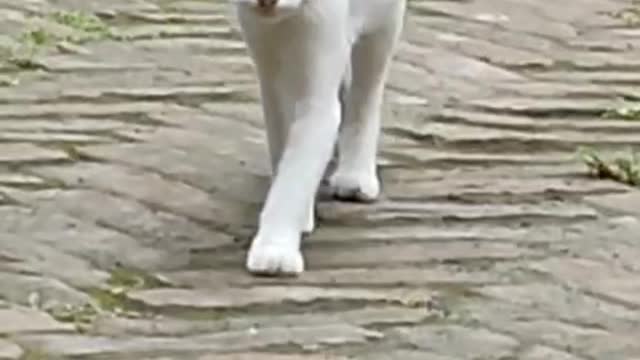Premium Only Content

My sweet pussy cat.
This article is about the species that is commonly kept as a pet. For the cat family, see Felidae. For other uses, see Cat (disambiguation).
"Cats" redirects here. For other uses, see Cats (disambiguation).
The cat (Felis catus) is a domestic species of small carnivorous mammal.[1][2] It is the only domesticated species in the family Felidae and is often referred to as the domestic cat to distinguish it from the wild members of the family.[4] A cat can either be a house cat, a farm cat or a feral cat; the latter ranges freely and avoids human contact.[5] Domestic cats are valued by humans for companionship and their ability to kill rodents. About 60 cat breeds are recognized by various cat registries.[6]
Cat
Temporal range: 9,500 years ago – present
Various types of cat
Conservation status
Domesticated
Scientific classificationKingdom:AnimaliaPhylum:ChordataClass:MammaliaOrder:CarnivoraSuborder:FeliformiaFamily:FelidaeSubfamily:FelinaeGenus:FelisSpecies:
F. catus[1]
Binomial nameFelis catus[1]
Linnaeus, 1758[2]
Synonyms
Catus domesticus Erxleben, 1777[3]
F. angorensis Gmelin, 1788
F. vulgaris Fischer, 1829
The cat is similar in anatomy to the other felid species: it has a strong flexible body, quick reflexes, sharp teeth and retractable claws adapted to killing small prey. Its night vision and sense of smell are well developed. Cat communication includes vocalizations like meowing, purring, trilling, hissing, growling and grunting as well as cat-specific body language. A predator that is most active at dawn and dusk (crepuscular), the cat is a solitary hunter but a social species. It can hear sounds too faint or too high in frequency for human ears, such as those made by mice and other small mammals.[7] Cats also secrete and perceive pheromones.[8]
Female domestic cats can have kittens from spring to late autumn, with litter sizes often ranging from two to five kittens.[9] Domestic cats are bred and shown at events as registered pedigreed cats, a hobby known as cat fancy. Population control of cats may be effected by spaying and neutering, but their proliferation and the abandonment of pets has resulted in large numbers of feral cats worldwide, contributing to the extinction of entire bird, mammal, and reptile species.[10]
It was long thought that cat domestication began in ancient Egypt, where cats were venerated from around 3100 BC,[11][12] but recent advances in archaeology and genetics have shown that their domestication occurred in Western Asia around 7500 BC.[13]
As of 2021, there were an estimated 220 million owned and 480 million stray cats in the world.[14][15] As of 2017, the domestic cat was the second most popular pet in the United States, with 95.6 million cats owned[16][17][18] and around 42 million households own at least one cat.[19] In the United Kingdom, 26% of adults have a cat with an estimated population of 10.9 million pet cats as of 2020.[20]
Contents
Etymology and naming
The origin of the English word cat, Old English catt, is thought to be the Late Latin word cattus, which was first used at the beginning of the 6th century.[21] It was suggested that the word 'cattus' is derived from an Egyptian precursor of Coptic ϣⲁⲩ šau, "tomcat", or its feminine form suffixed with -t.[22] The Late Latin word may be derived from another Afro-Asiatic[23] or Nilo-Saharan language. The Nubian word kaddîska "wildcat" and Nobiin kadīs are possible sources or cognates.[24] The Nubian word may be a loan from Arabic قَطّ qaṭṭ ~ قِطّ qiṭṭ. It is "equally likely that the forms might derive from an ancient Germanic word, imported into Latin and thence to Greek and to Syriac and Arabic".[25] The word may be derived from Germanic and Northern European languages, and ultimately be borrowed from Uralic, cf. Northern Sami gáđfi, "female stoat", and Hungarian hölgy, "lady, female stoat"; from Proto-Uralic *käďwä, "female (of a furred animal)".[26]
The English puss, extended as pussy and pussycat, is attested from the 16th century and may have been introduced from Dutch poes or from Low German puuskatte, related to Swedish kattepus, or Norwegian pus, pusekatt. Similar forms exist in Lithuanian puižė and Irish puisín or puiscín. The etymology of this word is unknown, but it may have simply arisen from a sound used to attract a cat.[27][28]
A male cat is called a tom or tomcat[29] (or a gib,[30] if neutered). An unspayed female is called a queen,[31] (or a molly,[32] if spayed), especially in a cat-breeding context. A juvenile cat is referred to as a kitten. In Early Modern English, the word kitten was interchangeable with the now-obsolete word catling.[33] A group of cats can be referred to as a clowder or a glaring.[34]
Taxonomy
The scientific name Felis catus was proposed by Carl Linnaeus in 1758 for a domestic cat.[1][2] Felis catus domesticus was proposed by Johann Christian Polycarp Erxleben in 1777.[3] Felis daemon proposed by Konstantin Alekseevich Satunin in 1904 was a black cat from the Transcaucasus, later identified as a domestic cat.[35][36]
In 2003, the International Commission on Zoological Nomenclature ruled that the domestic cat is a distinct species, namely Felis catus.[37][38] In 2007, it was considered a subspecies, F. silvestris catus, of the European wildcat (F. silvestris) following results of phylogenetic research.[39][40] In 2017, the IUCN Cat Classification Taskforce followed the recommendation of the ICZN in regarding the domestic cat as a distinct species, Felis catus.[41]
-
 LIVE
LIVE
Bitcoin on Rumble
1 hour agoBitcoin Blocks > USD Bricks
201 watching -
 LIVE
LIVE
Welcome to the Rebellion Podcast
17 hours agoI Love L.A. - WTTR Podcast Live 6/9
703 watching -
 LIVE
LIVE
Game On!
13 hours ago $0.03 earnedNHL Stanley Cup Finals Has Been ELECTRIC! Here's Why Nobody Is Watching
1,908 watching -
 LIVE
LIVE
The Bubba Army
2 days agoLA on FIRE! - Bubba the Love Sponge® Show | 6/09/25
3,401 watching -
 LIVE
LIVE
PudgeTV
2 hours ago🟠 Mafia II: Definitive Edition | Live Playthrough | Gaming on Rumble
48 watching -
 29:46
29:46
Degenerate Plays
6 days ago $0.08 earnedBack Where It All Began - Batman: Arkham Asylum : Part 1
11.6K1 -
 LIVE
LIVE
MrR4ger
58 minutes ago@ 12PMCST NEW STALKER-LIKE PVPVE MMO OPEN BETA (PIONER) / HITMAN, MORTALL SHELL, ETC TILL THEN.
37 watching -
 LIVE
LIVE
BEK TV
2 days agoTrent Loos in the Morning 6/9/2025
391 watching -
 10:05
10:05
China Uncensored
21 hours agoChina’s Military Fears This One Thing
25.3K10 -
 10:08
10:08
Rethinking the Dollar
12 hours ago10 Brutal Signs America’s Economy Is Quietly Collapsing
21.7K20